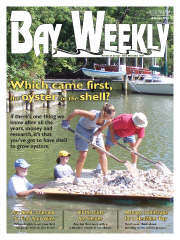Chesapeake Bay's Independent Newspaper ~ Since 1993
1629 Forest Drive, Annapolis, MD 21403 ~ 410-626-9888
Volume xviii, Issue 17 ~ Apri 29 to May 5, 2010
Home \\ Correspondence \\ from the Editor \\ Submit a Letter \\ Classifieds \\ Contact Us
Best of the Bay \\ Dining Guide \\ Home & Garden Guide \\ Archives \\ Distribution \\ Advertising![]()


The Potomac Gives up Its TrashThere’s a lot of weird stuff in 117.65 tons of wasteOver 7,055 volunteers waded into the murky depths of the Potomac River and its tributaries at the 22nd annual Potomac River Watershed Clean-Up. They emerged with over 117.65 tons of waste and litter. Those numbers are still climbing: The cleanup continues thru May 1. After all these years, there’s still plenty to clean up, according to Potomac River Watershed Cleanup Coordinator Becky Horner of the Alice Ferguson Foundation. The environmental education non-profit, based in Accokeek, has spearheaded anti-litter programs such as the Trash Summit in Washington as well as the annual Cleanup. “We do good work every year at picking up people’s litter,” reports Horner. “But the behavior has not changed, and that’s really the root of the problem — people’s littering.” With half the 512 clean-up sites reporting their findings, the numbers are staggering. Compounding the waste were 11,400 recyclable containers and 19,306 plastic bags that could have been easily reused instead of drowned in the water. Smokers tend to be litterbugs, the evidence shows. Teams removed 13,958 cigarette butts from the water. While they worked, volunteers kept an inventory of their watery findings. The most common items fished out of the river were consumable-product packaging, with Budweiser, McDonalds, 7-Eleven, Coca-Cola, Corona, Pepsi and Deer Park being the most popular brands tossed into the watershed. The list gets better. Ambitious volunteers removed a large, repairable canoe, a gas grill, a gumball machine and a weight bench. Other items found, it seems, were never meant to surface, such as a canine carcass, a tire with a skull lodged in it and “personal toys and viewing materials.” “We get shocking stuff each year. Every year it’s something different,” says Horner, who in past years has reported cars and prosthetic legs pulled from the water. “This year a third grader pulled a potty out of the Hard Bargain Farm site.” Each year the Alice Ferguson Foundation reports more volunteers willing to wade into the water, but the Foundation also reports an increase in the volume of trash those volunteers remove. The Foundation is still compiling data on whether the trash increase is due to more littering or more conscientious volunteers. “Right now we’re working on a watershed-wide education campaign,” Horner says. “It’s called Potomac River Outreach and Awareness Campaign for Trash. Pro Act for short. It is an anti-littering campaign for the watershed.” As volunteers continue to report their findings, check the Alice Ferguson Foundation’s website for updates on total waste removed and continued listing of interesting items removed from the water: www.fergusonfoundation.org/trash_initiative/ trash_cleanup.shtml. –Diana BeechenerUpdate: Get Your Cash for Clunker Appliances Now!Time runs out when the money’s gone
|
© COPYRIGHT 2010 by New Bay Enterprises, Inc. All rights reserved.



